The oak is Great Britain’s best-known tree and certainly the nation’s favourite. There are more oak trees in Great Britain than any other tree. It is one of the reasons why England “ruled the waves”; HMS victory was constructed from over 6,000 oak trees and the song “Hearts of Oak” is the official march of Great Britain’s Royal Navy. This was good news for oak trees; we couldn’t plant enough of them. One naval officer called COLONEL Thomas Jones planted almost a hundred thousand of them.
A 12,000-year history
Oaks have been common to these islands since the end of the last Ice Age, some 12,000 years ago. An oak tree can live for over 1,000 years and can grow over 30 metres tall; we mention some famous old oak trees below. Oak has also been a focus of several religions: Druids would enact pagan rites in oak groves; it is traditional for couples to marry in the shade of an oak tree; Yule Logs are made from oak branches; and many people carry acorns believing them to be lucky charms.
Properties and uses of oak
Oak timber has some remarkable properties. It is a dense wood with a physical density of 0.75 g/cm3 which gives it high strength and hardness. Many oaks are rich in tannins making them highly resistant to insect attack and fungi. These properties make oak the timber of choice for construction, particularly for architectural load bearing beams and flooring. But oak is used for many other purposes too, particularly in winemaking and distilling. Oak barrels add flavour and texture to wines and whisky, with different kinds of oak associated with different flavours. Oak is used to make Japanese drums and other musical instruments; oak bark and acorns are said to have medicinal properties, and oak galls were traditionally used to make long lasting inks.
Oak pollination – females prefer pollen from distant trees
Oaks prefer long distance pollination. Although oak trees are monoecious, which means they have both female and male flowers on the same tree, the female oak flowers are fussy about where the male pollen they fertilise with comes from. The pollen is carried by the wind, so pollen grains from local trees are far more abundant than pollen from distant trees, but the female flowers much prefer pollen from distant trees and reject pollen from local trees.
Oaks of Great Britain
Worldwide there are around 600 species of oak, genus Quercus, all native to the northern hemisphere, but of these are just two species are native to Great Britain and three other non-native oaks are commonly found in these islands. Below you will find a detailed guide to these wonderful trees that will help you identify them, but first we will mention examples of famous ancient oaks you can visit some of which are thought to be around 2,000 years old.
Famous British oaks
There are many ancient oaks to be found in Great Britain, and one of the best places to see an extensive collection of them is Blenheim Palace in Oxfordshire. Created originally as a hunting place for King Henry I and left untouched since then, the 120-acre High Park has more ancient oaks than any other site in England. In total there are sixty of them with several having diameters of around 9 metres.
Some ancient oaks, however, have found their way into legend. Here are a few you should really make a point of visiting.
The Major Oak
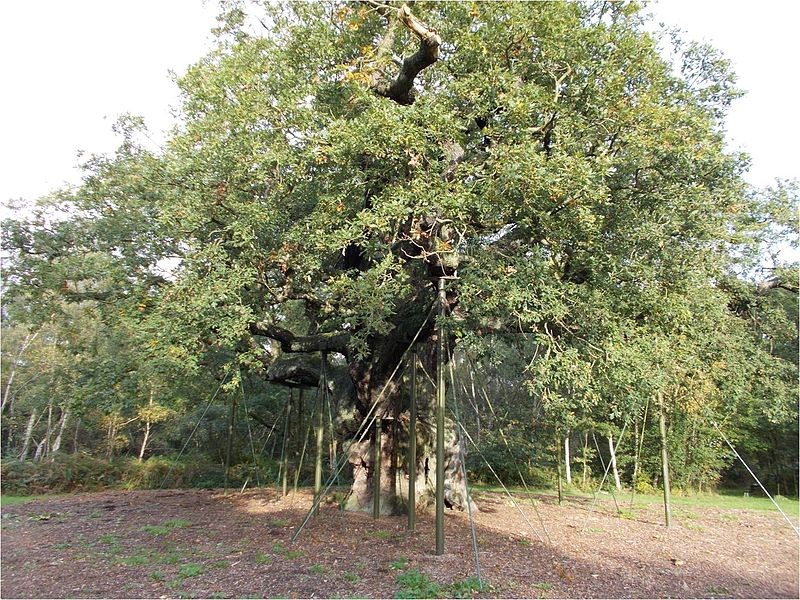
By Dadulinka – https://commons.wikimedia.org/w/index.php?curid=29097712
Estimated to be between 800 and 1,000 years old, The Major Oak in Sherwood forest Nottinghamshire is said to have been used as a shelter for Robin Hood. Its girth is 10 metres and it has a 28-metre canopy. Today its branches are kept aloft by a system of scaffolding. At one time you could buy its acorns (illegally) on eBay.
The reason for its strange shape may be because it formed from several saplings that fused together.
Bowthorpe Oak

By Robin Jones, CC BY-SA 2.0, https://commons.wikimedia.org/w/index.php?curid=13385191
The Bowthorpe Oak in Lincolnshire is over 1,000 years old, making it one of the oldest oak trees in England. Its hollow trunk is fitted with seats and has been used as a dining room. It has a 12.5 metre girth and it is quoted in the Guinness Book of Records.
Gog and Magog
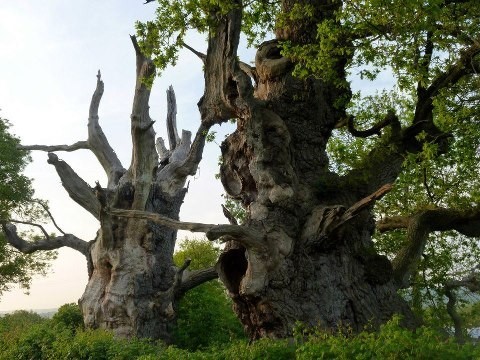
These two ancient oak trees grow at the bottom of Glastonbury Tor, Somerset. Known as the Oaks of Avalon as they were considered a traditional entry place, they are thought to be 2,000 years old, in fact the oldest oaks we know of. Sadly Gog, the far one in the picture, was damaged by fire in April 2017, though the fire didn’t spread to Magog. The names Gog and Magog come from a legendary race of giants, all of which were slaughtered by Brutus apart from Gog and Magog.
Birnam Oak

The Birnam Oak at Perth and Kinross, Scotland is a Sessile oak. In legend it is known as Macbeth’s oak and Birnam Wood features in William Shakespeare’s play. It has a 5.5 metre trunk.
Great Britain’s five species of oak
As we have said, although there are 600 species of oak worldwide, there are just five common oak trees to be found in Great Britain, two native and three imported. Four of them are deciduous and one is an evergreen. Here is a guide to help you identify them in both summer and winter.
English Oak (Quercus robur)
This is the most common oak in England. It is deciduous and can grow up to 40 metres in height and forms a wide spreading open canopy which allows light to penetrate. The bark is silver in colour and smooth, though develops deep fissures as the tree ages. When young it grows quite quickly, but the growth rate slows after the first hundred or so years. Like most oaks, it shrinks when it grows very old.

Origin: England
Leaves: smooth edged leaves have 4 or 5 lobes and usually burst in mid-May.
Flowers: long yellow catkins.

Fruit: acorns are around 2 to 2.5 cm long and held in capsules which grow on long stalks.
CC BY-SA 3.0, https://commons.wikimedia.org/w/index.php?curid=194973
How to Identify: In summer the tree can be identified by its leaves, flowers and shape; in winter you can spot clusters of round buds which have four or more scales.
Uses:
This has one of the hardest and most durable woods and is widely used in construction, particularly architectural beams and flooring. Trees should be at least 150 years old before they are suitable for this purpose. Other uses are wine barrels and fire wood.
Sessile oak (Quercus petraea)
The Sessile oak is deciduous and considered to be the traditional tree of Ireland. Usually it is found on hilly regions throughout Europe. It grows up to 40 metres in height and has a broad spreading canopy that lets the light through so allowing other plants to thrive under the tree. The bark is smooth and silver brown in colour, though develops fissures as it ages.
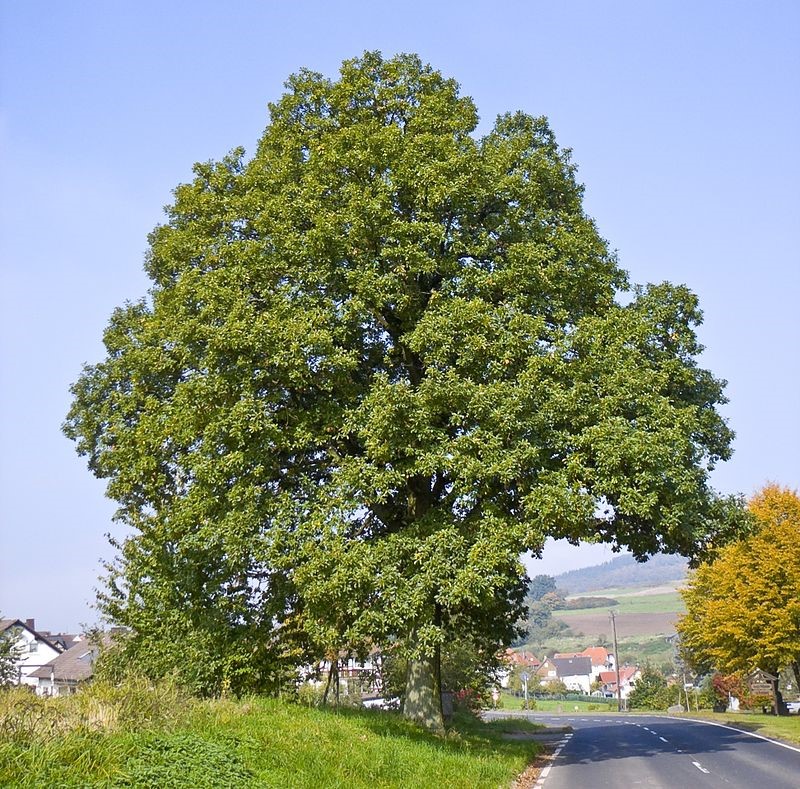
By Willow – Own work, CC BY 2.5, https://commons.wikimedia.org/w/index.php?curid=2920391
Origin: UK
Leaves: Lobed dark green leaves with saw-like teeth on the edges
Flowers: Male flowers form green catkins and female flowers form as red flower buds.

Fruit: acorns are around 2 to 2.5 cm long and held in capsules which grow on long stalks. The start out as green and turn brown as they mature
How to Identify: In summer the tree can be identified by its leaves, flowers and shape; in winter you can spot clusters of round buds which have four or more scales.
Uses:
Construction; typically beams and flooring. It is also used for wine barrels and firewood.
Non-native oaks commonly found in Great Britain
Holm oak (Quercus ilex)
This is an evergreen oak which can grow up to 20 metres height. The crown is large with a rounded shape. Originally from the Mediterranean, the tree was introduced to Great Britain around 1500. It is the only evergreen oak found in Great Britain. It has dark almost black bark with fine cracks. Twigs thin and hairy.
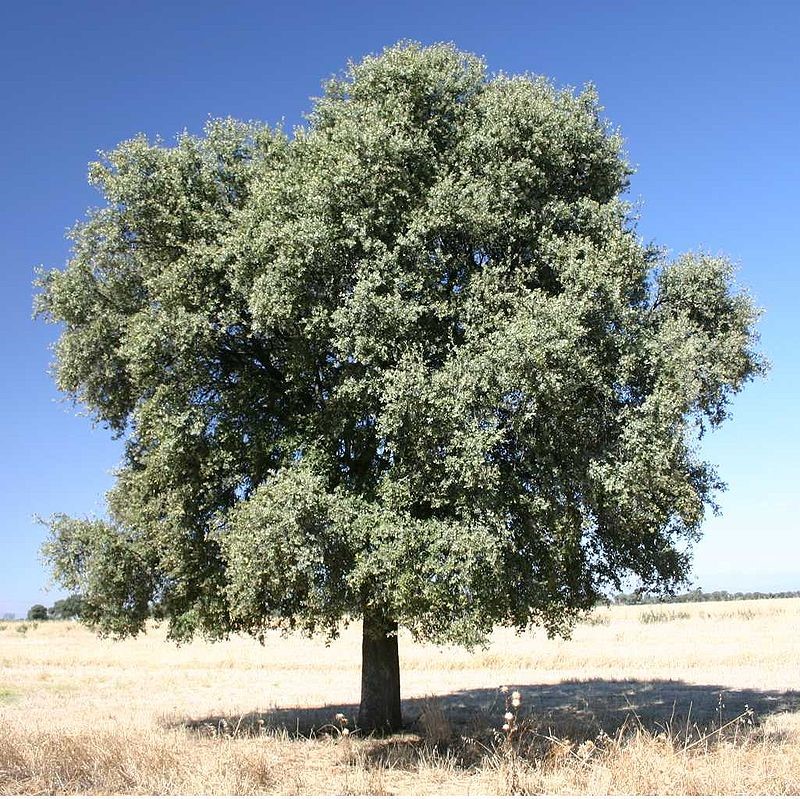
Origin: Mediterranean
Leaves: Oval dark green to black with hairs on the underside. When young leaves are spiny resembling holly leaves though become smoother as they age. Leaves of old trees are also smoother.
Flowers: Male flowers are yellow catkins.
Fruit: small acorns less than 2cm
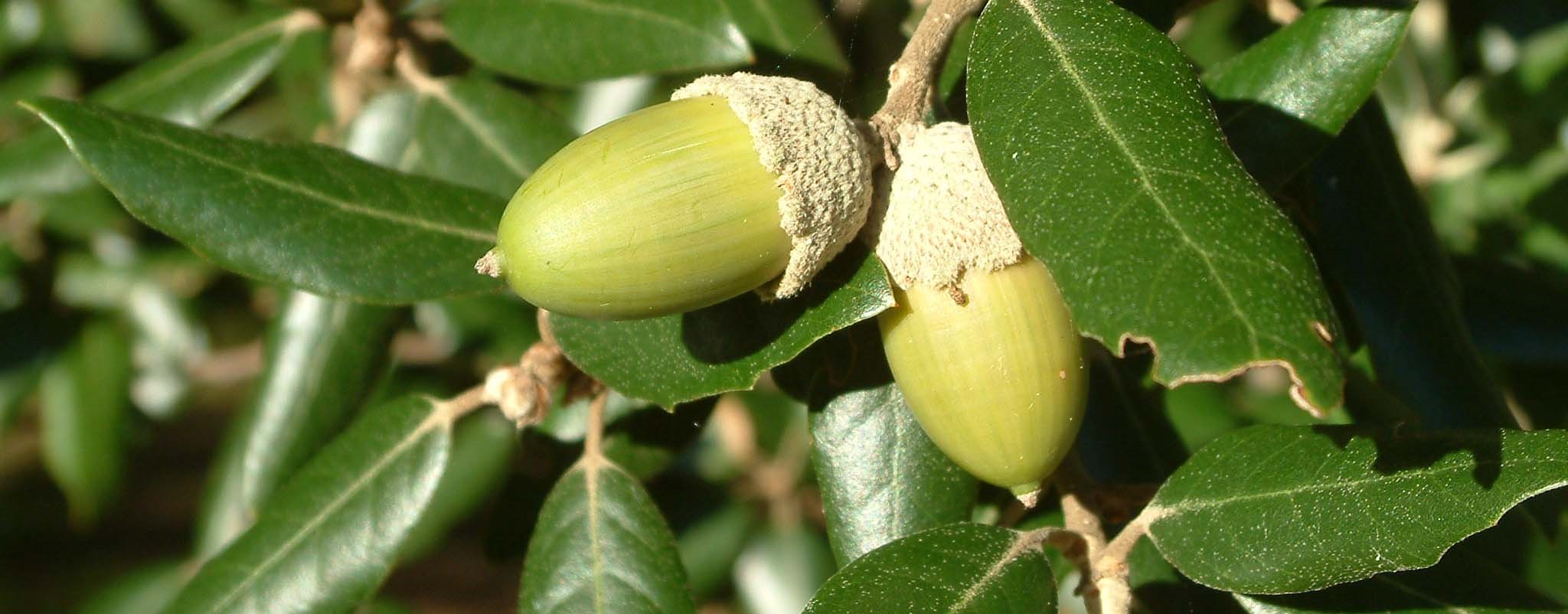
How to Identify: As it is evergreen it can be readily identified throughout the year by its general appearance.
Uses: The tree can be shaped and is often used as decorative features in parks and woodland. It is also used as a windbreak in coastal areas as it is resistant to salt spray.
The Romans used the Holm oak for making chariot and cart wheels. Today it is used as firewood and its acorns are used for pig feed.
Red oak (Quercus rubra)
The Red oak is deciduous and native to America and it is uncertain when it was introduced to Great Britain. It can grow to 20 metres height and has a rounded crown. Unusually it is 20 years before it flowers and forty years before it produces abundant quantities of fruit. Its silver-grey bark is smooth initially but develops ridges as it ages.

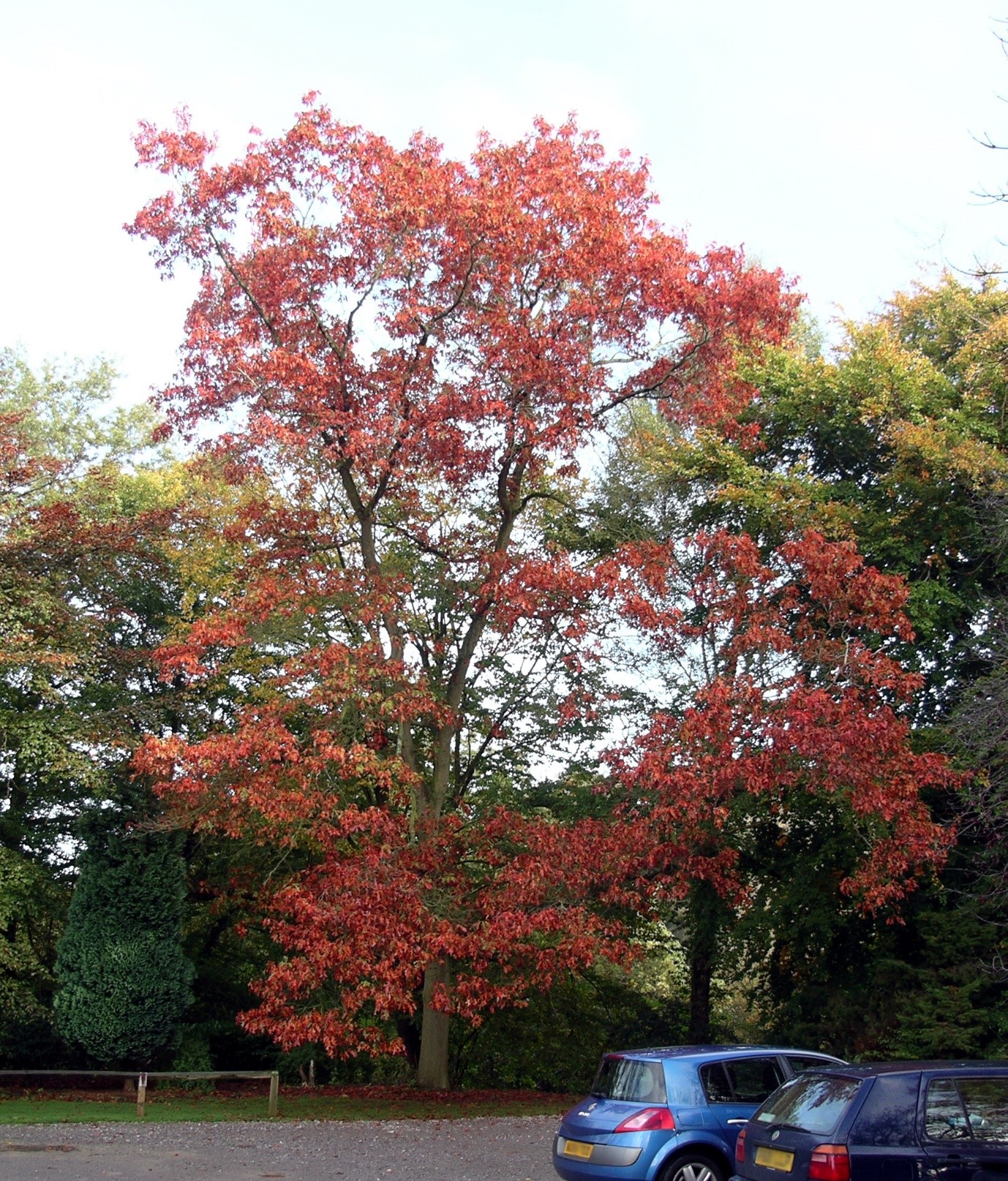
Leaves: smooth edged leaves have 4 or 5 long lobes but more pointed than the English oak and dark green in colour and matted on the underside. Develop a bright red appearance in autumn.

Flowers: thin male catkins and small female flowers either singly or in clusters.
Fruits: Small acorns with shallow cups ripen over two years.
How to Identify: In winter it can be identified by its bark and general shape.
Uses:
Mostly used as ornamental trees in gardens and parks due to its spectacular autumnal red colour. While the timber is used it is inferior to timber derived from English and sessile oaks.
Turkey oak (Quercus cerris)
The Turkey oak is deciduous and native to Asia Minor and south-eastern Europe. The tree can grow to 30 metres and was introduced to Great Britain during the 18th century as an ornamental tree. It has a dark grey bark that develops deep fissures and plates as it ages. The leaves are dark green and thick with a shiny top and velvety underside; they are also variable in shape: some have rounded lobes some have highly elaborate lobes.

The Turkey oak was considered sacred in several cultures to the Gods of Thunder: Zeus, Jupiter, and Dagda. They are sometimes considered to be a pest as they are host to Andricus quercuscalicis, the gall wasp, which damage native British oaks.
Leaves: Deeply cut lobes that are variable in appearance
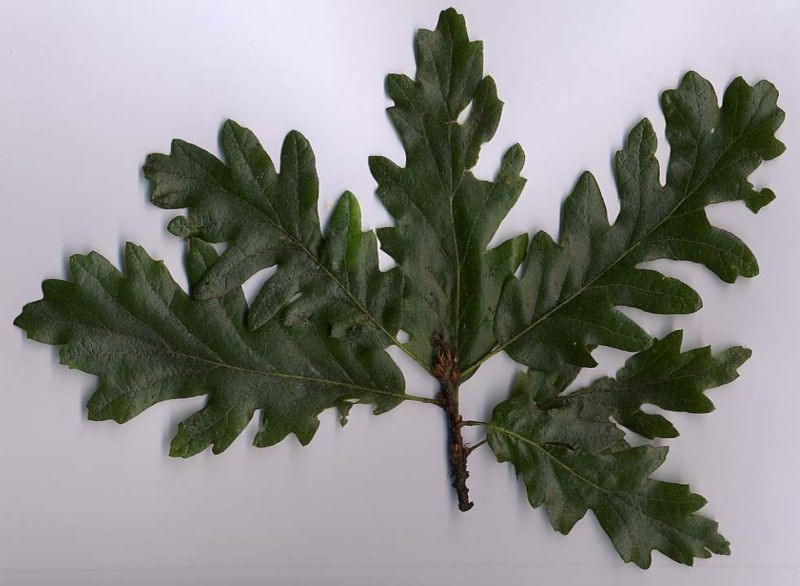
CC BY-SA 3.0, https://commons.wikimedia.org/w/index.php?curid=1075528
Flowers: male flowers are yellow catkins and female are small, appearing in clusters.
Fruit: Large acorns that mature after around 18 months.
How to Identify: In winter it can be identified by acorn cups that are more hairy than other oaks.
Uses: Mainly ornamental though sometimes considered to be a pest so nowadays rarely planted.
Are British oaks endangered?
Although there are many oaks in Britain and there are laws protecting them, they are threatened by a variety of pests and diseases. One danger is the processionary moth. This non-native pest arrived from Europe and is often found in southern England. It can cause leaf damage and weakens the tree making it susceptible to various diseases.
Other serious conditions include chronic oak decline and acute oak decline are common throughout central and southern England. Trees suffering from them can be spotted by their thinning canopies and dying branches. Often, they also have black sticky patches and lesions.
